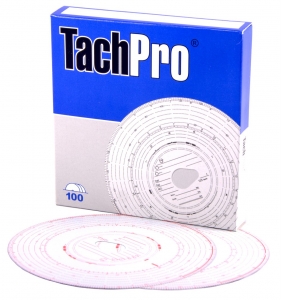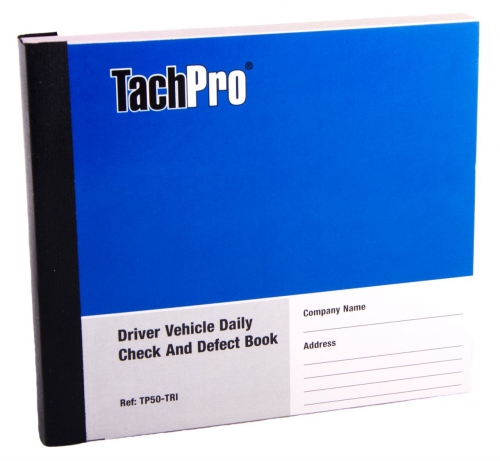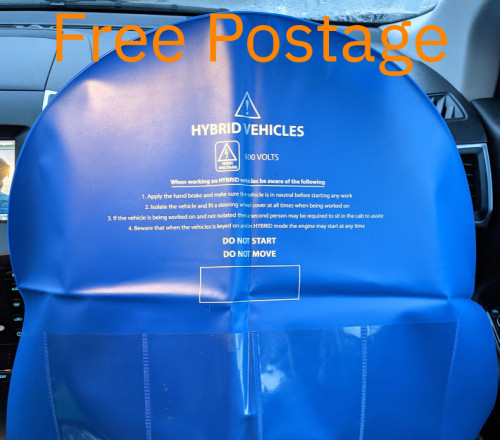Product Description
Analogue Tachograph Charts – 125km – 100 Charts per pack.
Suitable for all of the following analogue tachograph units and vehicles.
### PLEASE NOTE: Please make sure you require 125km charts and NOT 140km ( Usually Buses / Coaches ) or 180km ( Usually minibuses ) before ordering. Thanks ###
VDO Siemens
VDO Continental
Siemens
Kienzle
MotoMeter
Jaeger
Veeder-Root
These 125 km black combination charts with pear shaped centre hole are excellent quality.
100 charts per box.
For more information please feel free to contact us on 01405 763688 or 07912 387830
See Here For More Information On Tachograph Rules and Drivers Hours Regulations
Analogue tachograph recordings are made by a stylus cutting traces into a wax-coated chart. Three separate styluses mark recordings of:
- for speed
- for distance travelled
- for the driver’s activity (known as the ‘mode’)
The inner part centre is used by the driver to write details of their name, location of start of journey, end location, date and odometer readings.
The reverse of a tachograph chart normally contains an area for recording manual entries and details of other vehicles driven during the period covered.

What do all the readings mean on a analogue tachograph chart
Charts and records
Drivers are responsible for operating the tachograph correctly in order to record their activities accurately and fully. Specifically, drivers must:
- to verify, before using an instrument, that it is correctly calibrated via the attached plaques and ensure that the time displayed is set to the official time of the country in which the vehicle is registered
- must ensure that the correct type of chart is being used for the specific model of tachograph in use
- you carry enough charts for the whole journey, including spare charts in case any become damaged or dirty
- you enter centrefield details at the first use of the chart, when changing vehicles and when completing the use of the chart (see ‘Centrefield entries’ section)
- also correctly operate the mode switch in order to record their activities accurately see Common rules
- use a second chart if a chart is damaged while in use and attach this one to the first chart on completion – there are other occasions when use of a second chart in a 24-hour period is unavoidable, namely when a driver changes to a vehicle with an incompatible tachograph to the chart in use or they change vehicle so many times that all the details cannot be accommodated on one chart
- make manual entries on the chart in respect of their activities away from the vehicle (see ‘Manual entries’ section), where the rules have been exceeded in an emergency, or to correct a recording
- make manual entries when the equipment malfunctions and report any such malfunctions to the operator or employer
- not use a chart to cover a period longer than 24 hours
- not remove the chart from the instrument before the end of their duty period unless authorised to do so. The rules do not specify who can authorise removal of the chart, but cases where charts can be removed include:
- a change of vehicle
- swapping charts or cards on multi-manned journeys
- to make manual entries in the event of an emergency, equipment malfunction etc
- return used charts to the operator within 42 days. This requirement must be complied with even when a driver changes employer
- be able to produce at the roadside:
- charts and any legally required manual records for the current day and the previous 28 calendar days
- the driver’s digital smart card if they hold one
- permit a DVSA examiner or police officer to examine the tachograph instrument and inspect charts
Time tips
Make sure the time is correct for am or pm – both times are displayed identically on an analogue tachograph’s 12-hour clock face. Analogue tachographs must continue to display the correct time – which for the UK includes adjustments for British Summer Time.
Activity record
Most analogue tachograph instruments in use are ‘automatic’. This means that the instrument will automatically record activity as driving when the vehicle is moving however it defaults to the selected mode switch setting when the vehicle stops so drivers need to ensure it is set to the appropriate mode for the activity being carried out when the vehicle is stationary.
Driver cards
Drivers who have been issued with a driver card are committing an offence if they are unable to produce this during a roadside inspection, even if they only drive analogue tachograph-equipped vehicles.
Centrefield entries
A driver is required to enter the following information on the centrefield of a tachograph chart that they are using to record their activities:
- surname and first name (the law does not stipulate which order the names are put in – but your employer may have a policy on this)
- the date and place (nearest town or city) where the use of the chart begins and ends. The year may be written in full or abbreviated – so both ‘2015’ and ‘15’ are acceptable – if the start and finish places are the same, both must be written on the chart – ditto marks are not acceptable
- the registration number(s) of vehicle(s) driven (which should be entered before departing on a new vehicle)
- the time at which any change of vehicle takes place
- the odometer readings:
- at the start of the first journey
- at the end of the last journey
- at the time of any change of vehicle, recording the readings from both vehicles
Note that the ‘total km’ field does not have to be completed.
It is not acceptable for written entries to extend outside the centrefield area if they might interfere with chart recordings. If, for example, the driver’s name or a place name is so long it must be abbreviated in order to avoid any possible interference with the recordings, the full name should be noted on the reverse of the chart.
Tachograph charts are required to provide space on their reverse side to record the additional information required in connection with changes of vehicles.
Manual entries
Drivers must produce a record of their whole daily working period. So when drivers are unable to operate the instrument, have not been allocated a vehicle, or are working away from the vehicle and have had to remove their tachograph chart, they must manually record their activities on the chart.
Manual entries may also be needed at other times – for example, if the tachograph develops a fault, or in the event of an emergency see ‘Unforeseen events’. Employers may also ask drivers to indicate on a chart where their duty (or rest) begins and ends, so that they can ensure that a full record has been submitted.
Most analogue charts have a specified place to make manual entries (usually on the reverse) however, manual entries can be made anywhere on the chart provided that they are clear and do not obliterate other recordings.
The following are examples of manual records.
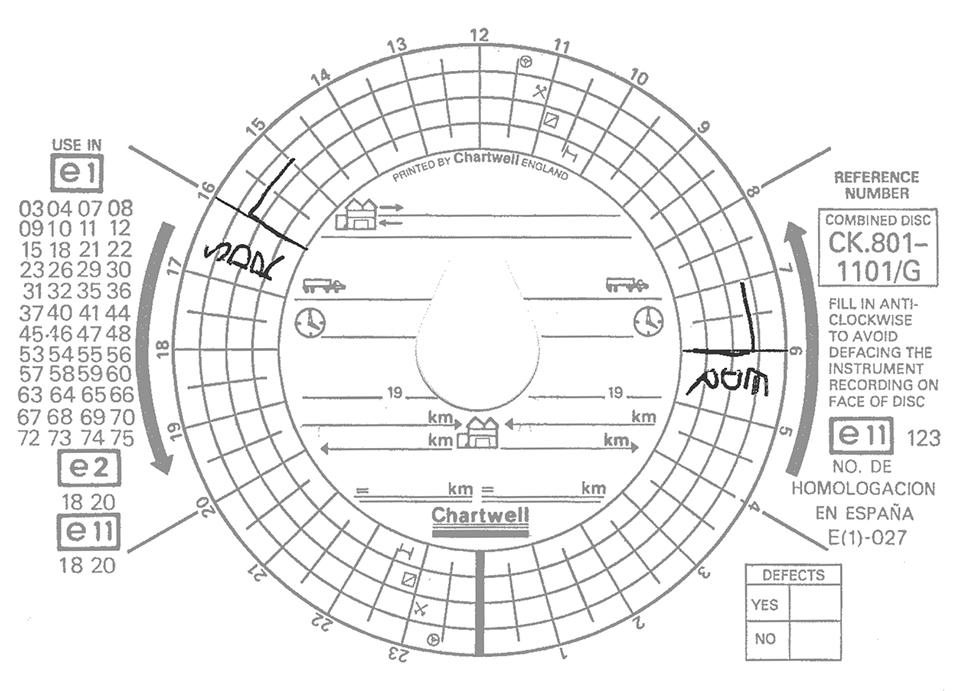
How do I fill in an analogue tachograph chart
This is an example of manual entries made on the rear of a tachograph chart of a driver who started their day at 06.00 with an hour’s work doing other duties away from their vehicle. They also finished their day with an hour of other work away from their vehicle and has indicated both the end and the start of a daily rest period. Their activities while with the vehicle are recorded by the instrument on the other side of the chart once it has been inserted.
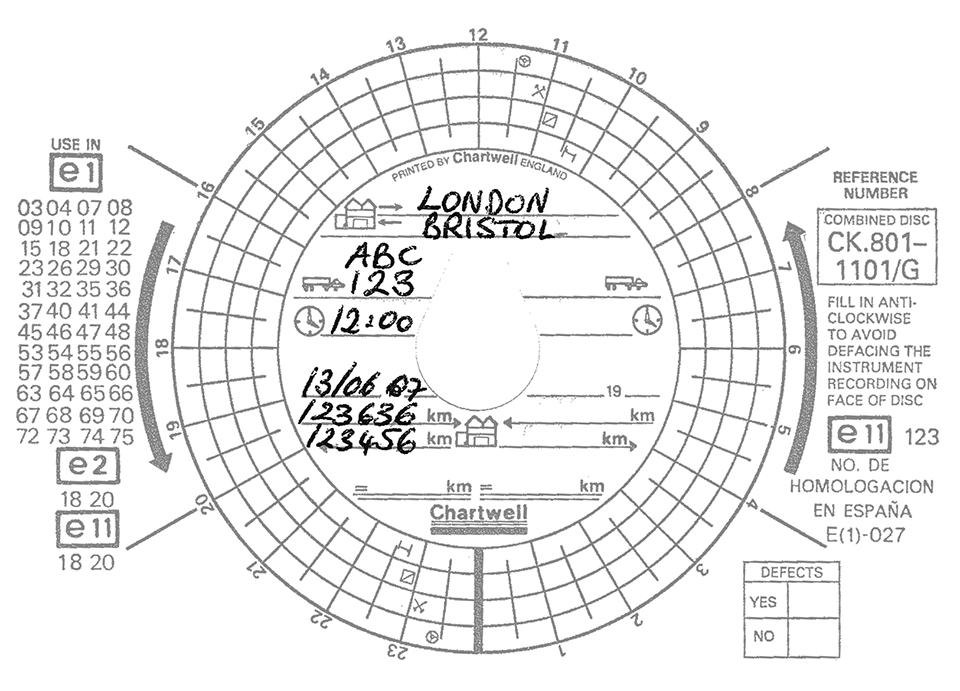
How to fill in a analogue tachograph chart
This is an example of the manual entries made by a driver who changed vehicles at 12.00 in London and continued their duties before finishing in Bristol. All the details of their activities and their name are listed on the other side of the chart.

Analogue Tachograph Charts for sale
This is an example of the manual entries that could have been made by a driver who discovered a tachograph fault at 12.00. They use the preprinted matrix to indicate their activities for the remainder of their duty until 18.30. They have also noted the reason for them keeping a manual record. All other details are provided on the other side of the chart.


